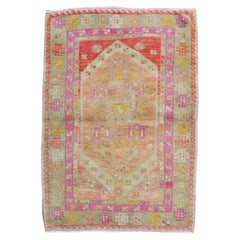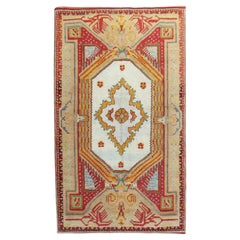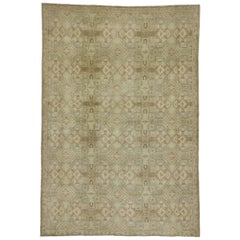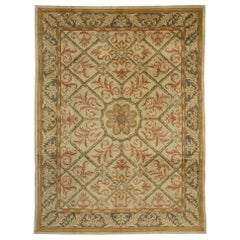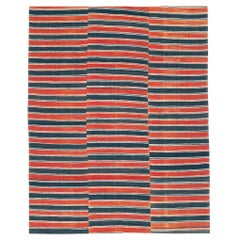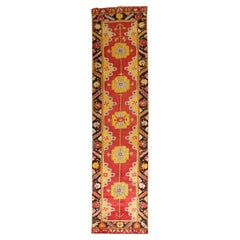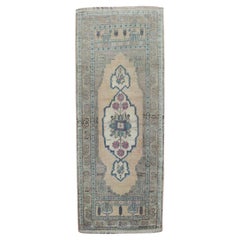Elizabethan Turkish Rugs
6
to
6
6
6
6
3,201
684
435
108
83
44
43
34
33
30
24
24
12
11
11
6
4
1
1
Width
to
Length
to
6
6
6
6
6
6
Style: Elizabethan
Antique Ghiordes Rug
Located in New York, NY
A colorful Turkish Ghiordes rug from the second quarter of the 20th century.
Measures: 2'6'' x 3'4''
Since the beginning of their production in the 18th century, rugs from the Turkish town, Ghiordes have mostly been known for their rectilinear, colorful, floral and multi-bordered antique prayer patterns. Ghiordes rugs often have open fields with mihrabs or hanging lamps and stylized architectural motifs that are found on 16th and 17th century Ottoman...
Category
Early 20th Century Turkish Elizabethan Turkish Rugs
Materials
Wool
Colorful Early 20th Century Antique Turkish Ghiordes Rug
Located in New York, NY
A colorful antique Turkish Ghiordes rug from the second quarter of the 20th century.
Measures: 3'8'' x 5'5''
Since the beginning of their production in the 18th century, rugs from the Turkish town, Ghiordes have mostly been known for their rectilinear, colorful, floral and multi-bordered antique prayer patterns. Ghiordes rugs often have open fields with mihrabs or hanging lamps and stylized architectural motifs that are found on 16th and 17th century Ottoman...
Category
Early 20th Century Turkish Elizabethan Turkish Rugs
Materials
Wool
Early 20th Century 'Royal Coat of Arms of the United Kingdom' Accent Rug
Located in New York, NY
An antique Turkish Sivas accent rug handmade during the early 20th century with a pictorial design of the 'Royal Coat of Arms of the United Kingdom.'
Measures: 5' 4" x 8' 6".
Category
Early 20th Century Turkish Elizabethan Turkish Rugs
Materials
Wool
Vintage Turkish Oushak Rug with Islamic Geometric Pattern and Elizabethan Style
Located in Dallas, TX
51038, vintage Turkish Oushak rug with Islamic geometric pattern and Elizabethan style. This hand knotted wool vintage Turkish Oushak rug beautifully...
Category
Mid-20th Century Turkish Elizabethan Turkish Rugs
Materials
Wool
Vintage Turkish Oushak Rug with Elizabethan Style and French Influence
Located in Dallas, TX
77116, vintage Turkish Oushak rug with Elizabethan style and French Influence. This hand knotted wool vintage Turkish Oushak rug features a central roundel surrounded by an all-over garden lattice...
Category
Late 20th Century Turkish Elizabethan Turkish Rugs
Materials
Wool
20th Century Bright Red Colorful Turkish Accent Rug
Located in New York, NY
A colorful Turkish Ghiordes rug from the second quarter of the 20th century.
Measures: 3'9'' x 6'3''
Since the beginning of their production in the 18th century, rugs from the Turkish town, Ghiordes have mostly been known for their rectilinear, colorful, floral and multi-bordered antique prayer patterns. Ghiordes rugs often have open fields with mihrabs or hanging lamps and stylized architectural motifs that are found on 16th and 17th century Ottoman...
Category
Early 20th Century Turkish Elizabethan Turkish Rugs
Materials
Wool
Related Items
Red & Black Mid-20th Century Handmade Turkish Flat-Weave Kilim Accent Rug
Located in New York, NY
A vintage Turkish flat-weave Kilim accent rug handmade during the mid-20th century with an asymmetrical horizontally striped design in shades of red and black.
Measures: 5' 9" x 7...
Category
Mid-20th Century Turkish Elizabethan Turkish Rugs
Materials
Wool
Zabihi Collection Early 20th Century Karapinar Bright Turkish 13 Foot Runner
Located in New York, NY
An early 20th century rich vibrant color turkish karapinar runner.
Measures: 3'2'' x 13'.
Category
Early 20th Century Elizabethan Turkish Rugs
Materials
Wool
Early 20th Century French Savonnerie Rug
Located in New York, NY
France, circa 1910
Handwoven
Measures: 21'0" x 16'6" (640 x 503 cm).
Category
Early 20th Century French Elizabethan Turkish Rugs
Materials
Wool
Neutral Vintage Turkish Oushak Rug 4' x 6'
Located in New York, NY
A vintage Turkish Oushak rug from the middle of the 20th century with a traditional medallion and border design in neutral colors
4'6'' x 6'7''
Category
20th Century Turkish Elizabethan Turkish Rugs
Materials
Wool
Vintage Turkish Oushak Rug
Located in WEST HOLLYWOOD, CA
A vintage Turkish Oushak rug in ivory and taupe colors. This rug is unique for it's tribal motifs that a simple in design yet interesting for the viewer's eye. This rug will bring ch...
Category
Early 20th Century Turkish Elizabethan Turkish Rugs
Materials
Wool
Antique Ghiordes Rug - 18th Century Anatolian Ghiordes Rug, Anatolian Rug
Located in Sultanahmet, 34
Antique Ghiordes Rug
18th Century Anatolian Ghıordes Rug Size 120 x 163 cm (47,2x64,1 In)
With ‘floating’ columns and an enlarged ‘mosque lamp’ motif dominating the red field of the...
Category
18th Century Turkish Antique Elizabethan Turkish Rugs
Materials
Wool
Geometric Antique Turkish Oushak Angora Rug
Located in New York, NY
Beautiful and impressive geometric antique Turkish Oushak angora rug, country of origin: Turkey, date circa 1900. Size: 9 ft. 9 in x 10 ft. 10 in (2....
Category
Early 20th Century Turkish Elizabethan Turkish Rugs
Materials
Wool
Early 20th Century French Needlepoint Rug
Located in New York, NY
Early 20th Century French Needlepoint Rug
France, ca. 1920
Category
Early 20th Century French Elizabethan Turkish Rugs
Materials
Wool
Vintage Oushak Rug from Turkey with Muted Colors and Floral Medallion
Located in Atlanta, GA
Vintage Oushak rug from Turkey with Medallion Design, rug/EN-176596 , country of origin / type: Turkey / Oushak, circa 1950.
This vintage Turkish Oushak rug features a faint, etch...
Category
Mid-20th Century Turkish Elizabethan Turkish Rugs
Materials
Wool
Mid-20th Century Handmade Turkish Oushak Throw Rug
Located in New York, NY
A vintage Turkish Oushak throw rug handmade during the mid-20th century.
Measures: 3' 7" x 5' 7".
Category
Mid-20th Century Turkish Elizabethan Turkish Rugs
Materials
Wool
Early 20th Century Handmade Turkish Oushak Runner
Located in New York, NY
An antique Turkish Oushak rug in runner format handmade during the early 20th century.
Measures: 2' 8" x 10' 9"
Turkish rugs & carpets:
Until the Great Persian Carpet Revival in the later 19th century, the “Oriental rug” was Turkish. For nearly six centuries, Turkish rugs, both scatter, room size, and even larger, thoroughly dominated the European import market. Whereas the Persian carpet can be divided into urban, village, and tribal types, in Turkey and its predecessor the Ottoman Empire, rugs almost exclusively came from village weavers and from a small number of urban workshops. Ninety percent village, nine percent city, one percent tribal.
Turkish weavers have, with very few exceptions, always worked with the symmetric (Turkish) knot. Wool foundations are standard practice among both town and village weavers. The exceptions, very finely woven 20th century and recent Herekeh silks from near Istanbul, and early 17th century Ottoman Court rugs from Bursa, constitute only a tiny part of the total. Always pricey, they appealed and still appeal to the clients who want lots of knots and perfect execution instead of individual personality.
The urban workshops have been centered around the western Turkish city of Oushak and its attendant port town of Smyrna. Oushak weaves with the trends in fashion. When color saturated medallion carpets were needed, Oushak was ready in the 17th and 18th centuries. When coarse red and blue carpets were required, Oushak and Smyrna in the 19th century wove them by the boatload. When tastes changed again, and the European dealers in Smyrna wanted room size carpets with lighter and unusual colors, and with Persianate designs, production ramped up in nearby Oushak. Those antique, all-wool construction turn-of-the-century carpets are still in high demand with designers. Antique carpets with allover, roughly drawn patterns on grounds of shrimp, rust, straw, cream, pale blue, and pale and pea green, hitherto unavailable colors, are in such demand today that contemporary Oushaks have attempted to mimic them with soft palettes, extra-large scale drawing and coarse weaves.
Oushaks woven for the Turkish market, for palaces, houses and mosques were often oversize with large, repeating medallions, all in shades of (Turkey) red, dark blue, light blue-teal, and ivory, with lemon and green accents. Turkey, along with India, invented standard sizes. By vertically repeating the medallion, one could get one medallion, one with two end halves, two, three, etc. medallions, up to thirty or so feet in length. The process spared making new cartoons for each length and allowed a quicker turnaround time. Oushak, from the time of 15th century “Holbein” rugs onward, has always been a commercial center.
The prayer niche directional rug is primarily a Turkish development. In the towns and villages east of Oushak, in Ghiordes, Kula, Ladik, Kirsehir, Mucur and Konya, among others, arch pattern scatters with bright palettes and weaves varying from relatively fine to moderate were almost the entire production. Antique examples were particularly popular in America around 1900.
Other centers of village weaving were situated on the western coast and adjacent islands with the town of Melas and neighboring villages weaving geometric prayer rugs and scatters with a characteristic khaki green and lots of yellow.
The other large region was in the northwest of Anatolia, near ancient Troy, with the sizable town of Bergama at its center. The satellite towns of Ezine, Karakecilli, Yuntdag, and Canakkale all wove colorful scatters with moderate weaves in all wool with geometric designs and cheerful palettes. Near to Istanbul, these were among the first Turkish rugs to reach Europe in the Renaissance.
The earliest Turkish pieces depicted in Italian Old Master paintings display the so-called “Memling gul”, an allover panel pattern with hooked and stepped elements within the reserves. This pattern continues for centuries in the Konya area and in the Caucasus as well.
Turkey is a land of villages and much of the most interesting Turkish weaving comes from one undiscovered village or another. The Konya-Cappadocia region of central Turkey includes the active towns of Karapinar, Karaman, Obruk, Sizma, and Tashpinar, all weaving Konya-esque scatters and long rugs. Karapinar has been active the longest, since the 17th century. The mosques in and around Konya have preserved locally-made rugs from the fourteenth. In the 20th century, the extra-long pile, many wefted Tulu rug was devised, with limited palettes and color block patterns. These are not really antique Tulus, but they must be a product of long-standing village tradition.
There are thousands upon thousands of rural Turkish villages, almost all with easy access to local tribal wool. Rug students are discovering new names and rug types almost daily. The common denominators are bright colors, geometric designs, wool construction, moderate to coarse weaves and symmetric knots. Synthetic dyes hit the Turkish rug industry quickly and hard after 1870, and they penetrated to even the most off-the-beaten-track villages. This development was almost entirely negative. The village weavers used fugitive or overly bright dyes which ruined the color harmonies built up over centuries. Characteristic types disappeared or were negatively transmuted. The Turkish village rug of the 1870 to 1920 period is nothing to be proud of.
In the eastern provinces, the semi-nomadic Kurdish tribes, collectively called ‘Yuruks’, weave all wool, geometric pieces with medium to medium-coarse weaves, as well as kilims and other flatweaves. The rugs employ cochineal instead of madder for the reds, mustard yellows, greens, and various blues. They are under-collected like the Persian Afshars. Their rugs are in scatter and long rug formats. The far eastern Turkish town of Erzerum has a long tradition of idiosyncratic, semi-workshop rugs and further to the east is Kars with a tradition of rugs in the Caucasian Kazak manner.
One Turkish specialty is the Yastiks or cushion cover, made in pairs for the public living rooms of village houses. These are larger rugs in miniature and good ones are highly collectible. Like other Turkish rustic weavings, ones with synthetic dyes are almost totally undesirable. Only the tribal Baluch make similar cushion covers, known as pushtis or balishts, in the same small, oblong format. Yastiks always have a back, usually in plain weave, so that they can be easily stuffed.
When the Imperial Carpet Factory at Herekeh near Istanbul closed in the early 20th century, the highly proficient Armenian master weavers set up in the Kum Kapi district of Istanbul where they wove all-silk, exquisitely fine and elaborately detailed small pieces, sometimes enriched with metal thread, for the most discriminating European buyers. Today the best, signed Kum Kapi pieces, usually in the “Sultan’s head” prayer niche design, can fetch upwards of $100,000. They are strictly for the wall. An Interwar all-silk room size Kum Kapi carpet is both exceedingly rare and stratospherically priced. The workshops closed in the 1930s, but the weaving of extremely fine, all-silk small rugs in Herekeh was revived in the 1960s.
There has been a recent vogue for larger Turkish village vintage...
Category
Early 20th Century Turkish Elizabethan Turkish Rugs
Materials
Wool
Mid-20th Century Handmade Turkish Anatolian Accent Rug
Located in New York, NY
A vintage Turkish Anatolian accent rug handmade during the mid-20th century.
Measures: 3' 6" x 6' 7"
Turkish rugs & carpets:
Until the Great Persian Carpet Revival in the later 19th century, the “Oriental rug” was Turkish. For nearly six centuries, Turkish rugs, both scatter, room size, and even larger, thoroughly dominated the European import market. Whereas the Persian carpet can be divided into urban, village, and tribal types, in Turkey and its predecessor the Ottoman Empire, rugs almost exclusively came from village weavers and from a small number of urban workshops. Ninety percent village, nine percent city, one percent tribal.
Turkish weavers have, with very few exceptions, always worked with the symmetric (Turkish) knot. Wool foundations are standard practice among both town and village weavers. The exceptions, very finely woven 20th century and recent Herekeh silks from near Istanbul, and early 17th century Ottoman Court rugs from Bursa, constitute only a tiny part of the total. Always pricey, they appealed and still appeal to the clients who want lots of knots and perfect execution instead of individual personality.
The urban workshops have been centered around the western Turkish city of Oushak and its attendant port town of Smyrna. Oushak weaves with the trends in fashion. When color saturated medallion carpets were needed, Oushak was ready in the 17th and 18th centuries. When coarse red and blue carpets...
Category
Mid-20th Century Turkish Elizabethan Turkish Rugs
Materials
Wool
Previously Available Items
Zabihi Collection Green Beige Mini Turkish Rug
Located in New York, NY
MId 20th century one of a kind handmade Turkish yastik rug
Measures: 1'10'' x 3'3''.
Category
Mid-20th Century Elizabethan Turkish Rugs
Materials
Wool
Floral Turkish Mini Rug
Located in New York, NY
MId 20th century one of a kind handmade Turkish yastik rug
Measures: 1'8'' x 3'10''.
Category
Mid-20th Century Elizabethan Turkish Rugs
Materials
Wool
New Contemporary Moroccan Style Rug with Diamond Harlequin Pattern
Located in Dallas, TX
53191, new contemporary Moroccan style rug with Diamond Harlequin pattern. Showcasing a diamond harlequin pattern with a Retro Mid-Century Modern flair, this hand knotted wool contem...
Category
21st Century and Contemporary Turkish Elizabethan Turkish Rugs
Materials
Wool
Vintage Turkish Oushak Runner
Located in New York, NY
A Turkish Oushak runner with a cranberry red medallion field and a dynamic border. Accents in yellow, green and pink too.
Category
20th Century Turkish Elizabethan Turkish Rugs
Materials
Wool
Distressed Vintage Turkish Sivas Rug with Modern Artisan and Art Deco Style
Located in Dallas, TX
50874 Distressed Vintage Turkish Sivas Rug with Modern Artisan and Art Deco Style. Warm and inviting combined with a bold pattern, this hand knotted wool distressed vintage Turkish S...
Category
Mid-20th Century Turkish Elizabethan Turkish Rugs
Materials
Wool
Antique Turkish Sivas Rug
Located in New York, NY
Exquisite small antique Turkish Sivas rug.
Category
20th Century Turkish Elizabethan Turkish Rugs
Materials
Wool
Elizabethan turkish rugs for sale on 1stDibs.
Find a broad range of unique Elizabethan turkish rugs for sale on 1stDibs. Many of these items were first offered in the Late 20th Century, but contemporary artisans have continued to produce works inspired by this style. If you’re looking to add vintage turkish rugs created in this style to your space, the works available on 1stDibs include rugs and carpets and other home furnishings, frequently crafted with fabric, wool and other materials. If you’re shopping for used Elizabethan turkish rugs made in a specific country, there are Asia, Caucasus, and Turkey pieces for sale on 1stDibs. It’s true that these talented designers have at times inspired knockoffs, but our experienced specialists have partnered with only top vetted sellers to offer authentic pieces that come with a buyer protection guarantee. Prices for turkish rugs differ depending upon multiple factors, including designer, materials, construction methods, condition and provenance. On 1stDibs, the price for these items starts at $1,700 and tops out at $18,375 while the average work can sell for $3,838.
Recently Viewed
View AllMore Ways To Browse
Oak Chairs Rush Seats
Louis Xv Serpentine Chest
Small Wood Dressers
Bedside Chests Mid Century
Small Arched Storage Cabinet
Wardrobe Oak Carved
Class Desk
Denmark Teak Wall Unit
Danish Teak Wall Unit
Refinished Antique Cabinet
Small English Commode
Pair Decorative Console Tables
Pair Of Rosewood Doors
Vintage Modern Wood And Metal Chair
Rosewood Teak Chairs Danish
Management Office Chair
Shoe Cabinet
Small Desk Inlaid
